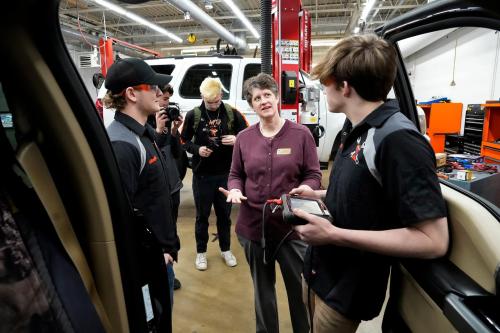This paper was prepared for the June 18, 2020, conference on Automation, Training, and the Middle Class for the Brookings Institution, Future of the Middle Class Initiative.
Automation and artificial intelligence (AI) are projected to either replace or fundamentally change human effort in many occupations. Some jobs may become obsolete. But the potential gains in productivity and efficiency from these technologies will likely transform legacy industries and lead to the emergence of new industries, generating new tasks and jobs. Displaced workers and new labor market entrants alike will therefore need to invest in skills and knowledge that complement these technologies.
Even before the recent employment crisis triggered by the COVID-19 outbreaks, we saw glimpses of these future labor market concerns. In particular, the difficulty many firms face in filling vacancies has raised broader concerns that our skilled labor force is not growing fast enough to keep up with demand. Businesses often cite skill mismatches between their workforce needs and those possessed by potential workers as a principal cause for these unfilled positions. Advances in automation and artificial intelligence will likely exacerbate this problem.
In response, some large employers have moved to invest in training and upskilling programs for their employees. Notwithstanding these important private-sector developments, most firms lack the resources, infrastructure, or desire to make these investments themselves. Ignoring this issue will have long-term consequences for labor markets, firms, and worker mobility. Public policy matters here.
At a recent webinar hosted by the Future of Middle Class Initiative on Automation, Training, and the Middle Class, two papers were presented, focusing on two distinct pathways for worker training: state-subsidized workplace training programs, and community colleges. Given that most US high-school grads remain unlikely to complete a 4-year college education in the near future, community colleges and other two-year institutions can play a pivotal role in mitigating skilled worker shortages and fostering middle-class mobility. Likewise, for incumbent workers facing potential displacement, subsidies that help support and provide incentives for private-sector firms to retrain their workers may be a key factor in saving jobs and increasing worker productivity and wages. I summarize these papers below, focusing on several key findings and their implications for labor market and training public policy.
State-Subsidized Workplace Training
In “State-level Policies to Incentivize Workplace Learning: Impact of California’s Incumbent Worker Training Paper,” Marian Negoita and Annelies Goger evaluate California Employment Training Panel (ETP). The ETP uses funding from a small payroll tax to reimburse employers for the costs of approved training for their employees. Using a mixed–methods approach, Negoita and Goger summarize findings from interviews, employer surveys and a quantitative assessment, focusing on various aspects of the program. In particular, they examine how ETP investments affect employers and workers and discuss some potential improvements to the program.
Negoita and Goger report several important findings. First, they find evidence that take-up of the program between 2014-2016 was generally concentrated among medium-sized to larger firms. as shown in Figure 1 below (adapted from Figure 2 of their paper). Although the vast majority firms in California are considered small (0-50 employees), they received less than 50 percent of approved funding for retraining.
Figure 1: Large CA firms receiving most public training dollars
 Sources: ETP administrative data for completed contracts, 2014-2016, and State of California Employment Development Department: Size of Business Data for California, 2015 Q1. (Small businesses 0-50 employees, medium businesses 51-250 employees, large businesses >250 employees).
Sources: ETP administrative data for completed contracts, 2014-2016, and State of California Employment Development Department: Size of Business Data for California, 2015 Q1. (Small businesses 0-50 employees, medium businesses 51-250 employees, large businesses >250 employees).
The authors attribute this skew in part to the administrative burden associated with applying and administering the program. In most cases, firms need to hire third-party consultants to help them through the process, making it cost prohibitive for smaller firms. Of course, smaller firms may also be less likely to need such funding if they are involved in services or are less likely to adopt new technologies and processes that require retraining. Nevertheless, given the importance of small business to the economy, efforts should be directed at ensuring that all firms have access to such support.
Second, the authors find evidence that ETP funding is associated with positive changes in company sales and employment. In main results shown in Figure 2 (from Figure 3 of their paper), ETP funding was linked to a 22 percent increase in jobs and work sites over a two-year observation period. The authors argue that ETP – funded training helped recipient firms to either create new jobs or prevent job loss and worker displacement.
Figure 2: ETP training funds boosted firm sales and jobs
 Source: Dun & Bradstreet (2019). Note: The stars denote statistical significance at the 95% level.
Source: Dun & Bradstreet (2019). Note: The stars denote statistical significance at the 95% level.
Third, ETP funds had their strongest impact among companies that were more than 10 years old; these firms had been active long enough to have established internal infrastructure and pathways for learning.
Fourth, the impacts of ETP were also strong among small or midsized businesses with between 19 and 100 employees (though as shown above, these firms were less likely to have received the funding). Importantly, small businesses were likely to invest the least in training overall, underlining the for a more equitable distribution.
Together these findings suggest that state-level programs that incentivize employers to retrain and upskill their existing workforces are a promising tool for addressing skills gaps and mitigating the likelihood of large layoff events. Likewise, providing such resources to firm may reduce the incidence of these persistent mismatch, helping firms to close vacancies faster, reducing productivity loss and promoting firm growth. These programs also provide a natural pathway for potential federal support for workplace retraining and upskilling programs.
Community Colleges and Training
In “Community College Program Choices in the Wake of Local Job Losses,” Miami University economist Riley Acton uses administrative data on the education choices of recent high school graduates in Michigan to study how labor market conditions influence students’ community college program decisions. Specifically, Acton matches programs offered at local community colleges to industries, based on the skills and tasks associated with typical occupations within that that industry. She then examines how local, occupation-specific job losses – that potentially alter the expected relative benefit of pursuing different programs – influence course choices.
Exploiting plausibly exogenous variation in exposure to mass layoffs and plant closings and the educational choices among high school leavers in different counties and at different times, Acton presents evidence that students respond to observed local labor market conditions by changing what they study – but not whether they enroll.
Acton’s preferred results suggest two central takeaways. First, as presented in the paper’s Table 4, reproduced below, increases in layoffs in an industry reduce the share of a high school graduates enrolling in the corresponding program at community college. So if a local hospital facility has a large layoff event, students reduce their enrollment in programs for x-ray and ultrasound technicians. This effect is sizable: each additional layoff per 10,000 working-age residents results in a nearly 1 percent decrease in the associated program’s enrollment.
Table 1: Enrollment in Response to Labor Market Disruption
| Enrollment in Occupation Group Programs per 100 H.S. Graduates | ||||
| Layoffs per 10,000 in: | (1) | (2) | (3) | (4) |
| Year following graduation |
0.007 (0.005) |
|||
| Senior year of H.S. |
-0.012** (0.006) |
-0.014** (0.007) |
-0.014** (0.007) |
-0.011* (0.006) |
| Junior year of H.S. |
-0.002 (0.004) |
-0.003 (0.005) |
-0.001 (0.005) |
|
| Sophomore year of H.S. |
-0.008** (0.004) |
-0.008* (0.004) |
-0.006 (0.004) |
|
| Freshman year of H.S. |
-0.004 (0.004) |
-0.005 (0.004) |
-0.002 (0.004) |
|
| 8th grade |
-0.007 (0.005) |
-0.004 (0.004) |
||
| 7th grade |
0.005 (0.005) |
0.007 (0.006) |
||
| 6th grade |
-0.002 (0.004) |
-0.000 (0.004) |
||
| 5th grade |
0.002 (0.005) |
0.004 (0.005) |
||
| Outcome Mean | 1.57 | 1.57 | 1.57 | 1.57 |
| County-Program-Year Obs. | 3,984 | 3,984 | 3,984 | 3,984 |
| R-squared | 0.488 | 0.489 | 0.490 | 0.490 |
| Notes: The unit of observation is a county-cohort-program triad. Outcomes are measured as the number students who initially enroll in a given vocational program within 6 months of high school graduation per 100 graduates in the county. The coefficients in each column are estimated from a separate regression and represent variants of β in equation (3), the effect of an additional layoff per 10,000 working age residents in a given occupation group on enrollment in corresponding programs. All standard errors are clustered at the county level. ∗p < 0.10, ∗∗p < 0.05, ∗∗∗p <0.01. | ||||
There is evidence, however, that students are substituting into the “next best” program in terms of skill requirements. Using rich data on occupational characteristics available in O*NET data provided by the Bureau of Labor Statistics (BLS), Acton shows that students primarily substitute into programs that feature similar skill requirements. Figure 3 below (adapted from Figure 4 of paper), illustrates these substitution patterns. The x-axis in each sub-graph represents a measure of the dissimilarity between the skills typically required for that sector and those predominant in the academic program. (A skill distance closer to zero suggests substantial overlap in skills for the employment sector and the academic program, whereas a skill distance closer to 1 suggests that the skill set overlap is very low). Acton’s results suggest that layoffs in business or health-related occupations decrease enrollment in health programs but increase enrollment in law enforcement programs. By contrast, layoffs in STEM and skilled trade occupations lead to little change in enrollment into other programs, perhaps because there are no close substitutes.
Figure 3: Program Substitution in Response to Layoffs

These results have several policy implications both in Michigan but at a national level. Most important, they suggest that student educational choices are malleable with respect to new and better information. Thus, as Acton argues in the paper, both community colleges and local high schools should look to provide more information on local and non-local labor market opportunities to potential students to help foster educational choices by students that better align with their geographical preferences and constraints. Of course, this also suggests that policy should facilitate better coordination between the program and curriculum choices offered by community colleges and the local private-sector needs.
Educational institutions should seek to anticipate student demand in response to these local labor market shocks. To do this effectively, however, community colleges will require more resources to ensure they can quickly expand alternative programs, particularly those with relatively higher labor market returns.
Given impending changes in the labor market, possibly accelerated by COVID-19, further exploration of these issues should be a priority. The Future of Middle Class Initiative at Brookings will continue to explore these issues in the subsequent months. Please continue to visit this space, and if you haven’t already, please sign up for our newsletter.
Sarah Nzau provided excellent research support for this paper.






Commentary
Looking towards the future: Automation, training, and the middle class
July 22, 2020